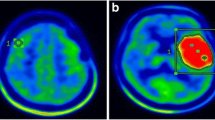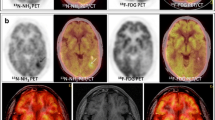Abstract
The aim of the present study is to evaluate the role of 11C-choline positron emission tomography/computed tomography (PET/CT) in detecting tumor recurrence and predicting survival in post-treatment patients with high-grade gliomas. A total of 16 previously treated histopathologically proven high-grade glioma patients were subjected to 11C-choline PET/CT scan and survival analysis. We found that the sensitivity and specificity of 11C-choline PET/CT were 100 and 70 %, whereas those of Gd-MRI were 83.3 and 60 %, respectively. By Cox regression analysis, 11C-choline T/N ratio correlated obviously with overall survival (OS) (hazard ratio = 2.644, 95 % confidence interval [CI] = 1.027–6.807, p = 0.044) independent of Karnofsky performance score. Patients with lower T/N ratio (tumor uptake/normal brain tissue uptake) (≤1.42) had longer survival times than patients with higher T/N ratio (median OS = 15.4 vs. 5.3 months, p < 0.001; progression-free survival (PFS) =4.5 vs. 0.8 months, p = 0.004). Thus, this preliminary study suggests that 11C-choline PET/CT is highly sensitive in detecting tumor recurrence in post-treatment patients with high-grade gliomas. Moreover, our preliminary results suggest that T/N ratio measured by 11C-choline maybe serves as a predictor of patients’ survival with suspected recurrent glioma.


Similar content being viewed by others
References
Clarke J, Butowski N, Chang S. Recent advances in therapy for glioblastoma. Arch Neurol. 2010;67:279–83.
Brandsma D, Stalpers L, Taal W, Sminia P, van den Bent MJ. Clinical features, mechanisms, and management of pseudoprogression in malignant gliomas. Lancet Oncol. 2008;9:453–61.
Caroline I, Rosenthal MA. Imaging modalities in high-grade gliomas: pseudoprogression, recurrence, or necrosis. J Clin Neurosci. 2012;19:633–7.
Shah AH, Snelling B, Bregy A, Patel PR, Tememe D, Bhatia R, et al. Discriminating radiation necrosis from tumor progression in gliomas: a systematic review what is the best imaging modality. J Neurooncol. 2013;112:141–52.
Knudsen-Baas KM, Moen G, Fluge O, Storstein A. Pseudoprogression in high-grade glioma. Acta Neurol Scand Suppl. 2013;196:31–7.
Chamberlain MC, Glantz MJ, Chalmers L, Van Horn A, Sloan AE. Early necrosis following concurrent Temodar and radiotherapy in patients with glioblastoma. J Neurooncol. 2007;82:81–3.
Jahangiri A, Aghi MK. Pseudoprogression and treatment effect. Neurosurg Clin N Am. 2012;23:277–87. viii-ix.
Patronas NJ, Di CG, Brooks RA, DeLaPaz RL, Kornblith PL, Smith BH, et al. Work in progress: [18F] fluorodeoxyglucose and positron emission tomography in the evaluation of radiation necrosis of the brain. Radiology. 1982;144:885–9.
Gulyas B, Halldin C. New PET radiopharmaceuticals beyond FDG for brain tumor imaging. Q J Nucl Med. 2012;56:173–90.
Ito K, Yokoyama J, Kubota K, Morooka M. Comparison of 18F-FDG and 11C-choline PET/CT for detecting recurrences in patients with nonsquamous cell head and neck malignancies. Nucl Med Commun. 2010;31:931–7.
Narayanan TK, Said S, Mukherjee J, Christian B, Satter M, Dunigan K, et al. A comparative study on the uptake and incorporation of radiolabeled methionine, choline and fluorodeoxyglucose in human astrocytoma. Mol Imaging Biol. 2002;4:147–56.
Hara T, Kondo T, Hara T, Kosaka N. Use of 18F-choline and 11C-choline as contrast agents in positron emission tomography imaging-guided stereotactic biopsy sampling of gliomas. J Neurosurg. 2003;99:474–9.
Nuutinen J, Leskinen S, Lindholm P, Söderström KO, Någren K, Huhtala S, et al. Use of carbon-11 methionine positron emission tomography to assess malignancy grade and predict survival in patients with lymphomas. Eur J Nucl Med. 1998;25:729–35.
Yang I, Aghi MK. New advances that enable identification of glioblastoma recurrence. Nat Rev Clin Oncol. 2009;6:648–57.
Karunanithi S, Sharma P, Kumar A, Khangembam BC, Bandopadhyaya GP, Kumar R, et al. 18F-FDOPA PET/CT for detection of recurrence in patients with glioma: prospective comparison with 18F-FDG PET/CT. Eur J Nucl Med Mol Imaging. 2013;40:1025–35.
Chen W, Silverman DH, Delaloye S, Czernin J, Kamdar N, Pope W, et al. 18F-FDOPA PET imaging of brain tumors: comparison study with 18F-FDG PET and evaluation of diagnostic accuracy. J Nucl Med. 2006;47:904–11.
Herrmann K, Czernin J, Cloughesy T, Lai A, Pomykala KL, Benz MR, et al. Comparison of visual and semiquantitative analysis of 18F-FDOPA-PET/CT for recurrence detection in glioblastoma patients. Neuro Oncol. 2014;16:603–9.
Siepmann DB, Siegel A, Lewis PJ. Tl-201 SPECT and F-18 FDG PET for assessment of glioma recurrence versus radiation necrosis. Clin Nucl Med. 2005;30:199–200.
Tan H, Chen L, Guan Y, Lin X. Comparison of MRI, F-18 FDG, and 11C-choline PET/CT for their potentials in differentiating brain tumor recurrence from brain tumor necrosis following radiotherapy. Clin Nucl Med. 2011;36:978–81.
Caroli P, Nanni C, Rubello D, Alavi A, Fanti S. Non-FDG PET in the practice of oncology. Indian J Cancer. 2010;47:120–5.
Hara T, Kosaka N, Kishi H. PET imaging of prostate cancer using carbon-11-choline. J Nucl Med. 1998;39:990–5.
Barker 2nd FG, Chang SM, Valk PE, Pounds TR, Prados MD. 18-Fluorodeoxyglucose uptake and survival of patients with suspected recurrent malignant glioma. Cancer. 1997;79:115–26.
Santra A, Kumar R, Sharma P, Bal C, Julka PK, Malhotra A. F-18 FDG PET-CT for predicting survival in patients with recurrent glioma: a prospective study. Neuroradiology. 2011;53:1017–24.
Acknowledgments
We thank the staff of the PET/CT Center, Shandong Cancer Hospital and Institute, particularly Shuqiang Zhao, Zheng Fu, Xiaorong Sun, and Jinsong Zheng, for their technical support. This work was supported in part by the Natural Science Foundation of Shandong Province, China (ZR2012HL41).
Conflicts of interest
None.
Author information
Authors and Affiliations
Corresponding author
Additional information
Wanhu Li and Li Ma equally contributed to this work.
Rights and permissions
About this article
Cite this article
Li, W., Ma, L., Wang, X. et al. 11C-choline PET/CT tumor recurrence detection and survival prediction in post-treatment patients with high-grade gliomas. Tumor Biol. 35, 12353–12360 (2014). https://doi.org/10.1007/s13277-014-2549-x
Received:
Accepted:
Published:
Issue Date:
DOI: https://doi.org/10.1007/s13277-014-2549-x




